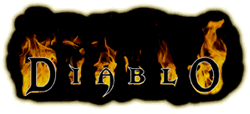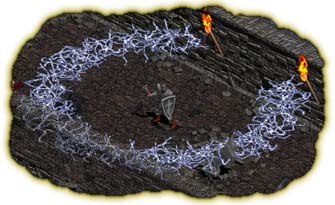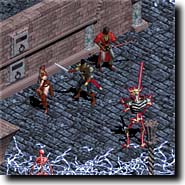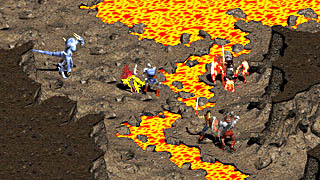


Company line: The kingdom of Khandaras has fallen into chaos. An unknown force of evil has swept across the land, plunging it into civil war and terrorizing the populace. A mad king, his missing son, and a mysterious Archbishop are all pieces to the puzzle that faces you. You have journeyed to the source of the evil, the town of Tristram, now inhabited by only a handful of survivors. The cathedral there is built over the ruins of an ancient monastery, and now eerie lights and sounds are heard echoing through its abandoned halls. Perhaps the answer lies within the remains of a forgotten past.
Diablo invites you to enter a world of dark Gothic fantasy. Play as a brave Warrior, cunning Rogue, or mysterious Sorcerer. As you venture deeper into the labyrinth, you'll discover weapons, armor, and magical treasures, and develop your character's skills and abilities. You might also want to bring a friend or two to help... Built in support for Battle.net, as well as modem, serial, and network play, insures that you'll never have to go in alone.
History: First there was Warcraft which took the gaming world by surprise.
Most thought the genre of strategy games dead. Then Warcraft came along and
sold over one million copies. Warcraft II sold over a million copies, a good
sequel it built on the past successes.

While at the 1996 Los Angeles Electronic Entertainment Expo, The Computer Show's Al Giovetti interviewed Bill Roper of Blizzard about the upcoming Diablo title. We hope you will enjoy his comments on the show and notice that many of those comments contribute to this article here.
Plot: You arrive in a small town named Khandaras that has been beset by evil in the form of a fiend from hell named Diablo. The townspeople are hanging on by their fingernails. Your job is to save them from the horrors that exist in the many levels in the basement of a local church. Quests emerge that propel you on your way, including setting the kings undead spirit to rest, finding the stolen sign of the local inn, avenging the death of many by killing "the butcher", and seeking the magical stone which fell from the sky.
There are from six to eight subplots in each game that are chosen from over 30 subplots making each game different.
Game play: You explore your surroundings, talk with the townspeople, kill the monsters down in the dungeon below the church, buy and sell artifacts to the mage, healer, blacksmith, and local black market. Anyone of the towns people can inform you of a quest. The pop-up quest list keeps track of your quests.
Within the town there is a healer who heals you and trades healing potions and scrolls, a witch magic user who trades spell books, scrolls, magic staves and magic potions, a blacksmith who trades weapons and armor, an inn keeper, a sage who gives advice, a drunk who also gives more confusing advice, and a black marketeer who sells unusual items.
Interface: A battle with the Lord of Evil, Diablo, Plays over internet directly. Plays and looks like the overhead oblique perspective (or three-quarter overhead isometric perspective) Ultima series of games from Origin. You travel around the town and the dungeons by clicking. Sadly there are no keyboard movement keys to save your hands from repetitive strain injury or appease those who like using the keyboard to move. Other keys are used to bring up half screen mats that have character attributes (the C key), quest list (Q), inventory items (I), spell book (B), and spells (s).
Below the half screen mats is a control panel with two globes of red and blue to show levels of life (hit points) and mana. In the center is the belt inventory and there is a text window that describes characteristics of selected items and displays the small signposts of the game.
When talking with a character, you hear their voice and a scrolling text window allows you to read ahead. Hitting any key will suspend the text. There is a lot of things to talk about with the town's people, but after a while they begin to repeat themselves and they get pretty boring.
There are eight slots on the belt also activated by the number keys either on
the number pad or above the letters on the keyboard. The pack contains a grid
of 10 by 5 spaces with different items occupying different spaces. A sword is
1x3. A shield, book, or helm is 2x2. Armor and magical staves are 2x3.
Potions, scrolls, rings, and amulets are 1x1.

The items are equipped in paper doll fashion where the items are hung on the doll above the inventory slots. You can have one armor, one helm, right and left hand, and two rings. Whenever a two handed weapon is used the second hand shows a shadow of the item carried in the right hand. Items take damage and must be repaired by the blacksmith.
Monsters you fight: You battle over 200 monsters, including toad deamons, storm riders, hell spawn, living corpses, skeletal warriors, and overlords. There is a wide and diverse stable of beasts to fight, making the game play engaging and interesting. Special super monsters are immune to spells and must be hacked to death making each encounter somewhat distressing.
Lands and quests: Maps are created by random room placement so that each game is different. There are 16 levels in the game from the top to the bottom of the dungeon.
Races, levels and other things CRPG: There are three classes to choose from, Warrior, Rogue, and Sorcerer, each with unique abilities. Character development is central to any CRPG and Diablo is not different in this respect. You can develop your character's skills, attributes, and spells as you explore the dungeon labyrinth. The sorcerer can recharge staves, the warrior repair weapons, and the thief can disarm traps. Only the thief's skill comes without a price, since recharging and repair will damage the artifact.
Artificial intelligence: Monsters will think of themselves and go off to automatically heal up when hurt. The monsters stop to consider the situation and if one of their own is killed they will go off and regroup. The monsters are difficult to pick off one at a time, since they gang up on you and surround you making it difficult to run away. The AI is designed to put the character off guard and take advantage of their weaknesses.
Graphics: The view is overhead oblique perspective of a "3D world of dark Gothic fantasy". SVGA game play and rendered cinematic sequences bring the horror to life. There are three dimensional modeled characters and real-time lighting effects. The resolution is 640 x 480 pixles and 256-color.
Floors are dark outside of the illumination of magical artifacts and torches. The darkness is oppressive and can be dissipated if needed with artifacts but at the sacrifice of other abilities.
Animation: The characters are animated well with staggering undead, precision skeleton warriors, skittering minor deamons.
Voice actors: Voice overs for each character in the game are distinctive and not overacted. There is a voice for each of the three character classes, the butch male fighter, the female thief, and the male wizard. The voices sound natural and relaxed without any pretense. The voices sound real. Thanks for a good job goes to voice actors Michael Haley, Glynnis Talken, Michael Gough, Paul Eiding, Lani Minella, Steve Brodie, Bill Roper, Mark Schwarz, Glenn Stafford, Chris Metzen, and Maz Schaefer.
Music score: The digital audio, not redbook audio, music tracks on the CD are context sensitive, adjusting to a new level or area with theme music.
Sound effects: Weapons clang, flames crackle, bones rattle, coins ring, and other sounds are equally accurate and complimentary. DirectSound provides panning effects and distance effects that work well to scare the pants off of you as you move thought the dungeon. Clips of human speech give the characters a realistic feel as they taunt you.
Each action has an associated sound. Arrows twang, fly through the air with a woosh and chunch into armor. This is a great use of sound effects and animation, totally in synch.
Utilities: There is an automapping system, which you cannot examine anymore than the local area of. There is no autotravel even in the town where there is no automap. Traveling from place to place can be a pain especially in town. A special spell, which can be activated by stave, mana, or scroll, the town portal spell, makes it easier to teleport from the dungeon back to town and then return to your place in the dungeon. The town portal works well but would have been better had there been other aids to getting around. There is only one save game slot per player character.
Multi-player: The Multi-player game is played with 4 humans via direct link, phone modem, IPX network or internet play. Play head-to-head or cooperatively over a modem, serial link, IPX network, and Battle.net. Battle.net is Blizzard's free Multi-player internet service. Blizzard was the first to offer this free service which has been emulated by Electronic Arts, and Westwood to name two. It is much more fun to explore with a small group than to explore alone. While the game is great solo, it is much better with four humans to cooperatively explore. There is latency when playing the game and it requires a 32-bit TCP/IP connection to the internet to play on Blizzard's Battle.net.
Battle.net is easy to use since all you need to play it is installed when you install the game. Primenet uses proprietary technology to increase speed and reduce latency or warping. Warping is the phenomenon that has one player in a different location than the other when playing the game, leading to your character being killed for no apparent reason. Getting on the battle.net requires only one click from the game player.
A multiplayer game cannot be saved and only lasts as long as there is at least one person online. When you leave the game or leave online your character is saved but any items you are not carrying are toast. The copy protection scheme for the multiplayer game will not allow you to switch computers and move your character from your home to office to vacation machines, and will denude and defrock any characters you try this on.
Hints: Immediately purchase a stave of town portal or some scrolls. This will enable you to jump from the dungeon to town and back again without clicking up the stairs over and over again. It will also save you the long load times for each level of the dungeon coming up.
Cheats: One cheat is found on the cheatzone (http://www.cheatzone.com) which works with the entire game. The Diablo Cheat is fine in that it changes the attributes of strength, dexterity, vitality and intelligence. You need to change these independently to adjust certain things.

It would be better if the cheat gave you more points to distribute when you went up a level, or allowed you to change mana or hit points.
As the cheat is, it prevents you from allocating points when you go up a level. And while people want to enhance their stats, they want it to not interfere with the regular game. And it needs to be more controllable by the user.
The Enigma Trainer is the best and it will allow you to change statistics by going up levels and adding the attribute points rather than the gross add which disabled increases in hit points and mana. Now, if they could only perfect the item editor, I would be content. Press: Industry vetran, Trent says, "Diablo is the best game to come out in the last year, buy it."
References:
Computer Games Strategy Plus, issue 70, September, 1996, pg. 68.
Video Game Time Online Review
http://www.blizzard.com/diablo/diablo.htm
http://www.blizzard.com/library/docs/960807d.htm
Ron Dulin, http://www.gamespot.com/previews/diablo/index.html
Trent C. Ward, http://www.gamespot.com/rpg/diabl/, 96%
Mike Wolf, PC Gamer, volume 4, number 3, March, 1997, pg. 102 - 103, 93%
Greg Fortune, Computer Gaming World, issue 152, March, 1997, pg. 80 - 81, 90%.
Brad Craig, Boot, volume 2, number 8, April, 1997, 100%.
Cindy Yans, Computer Games, issue 77, April, 1997, pg. 84-85, 80%.
Paul Bannister, Computer & Net Player, volume 3, number 10, pg. 60, 100%.